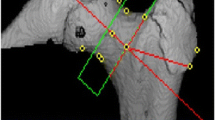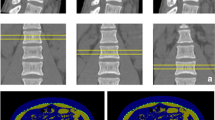Abstract
Summary
We analyzed volumetric bone mineral density, by 3D analysis, in 76 people with Down syndrome and 76 controls. People with Down syndrome, particularly men, have a lower hip volumetric bone mineral density than the general population. Besides, volumetric bone mineral density declines more rapidly in Down syndrome.
Introduction
People with Down syndrome (DS) have a lower areal bone mineral density (aBMD) estimated by dual-energy X-ray absorptiometry (DXA). However, they have smaller-sized bones, which could influence the measurements. Therefore, our objective was to determine volumetric BMD in these patients.
Materials and methods
We included 76 outpatients with DS and 76 control healthy volunteers matched for age and sex distribution. Clinical data were obtained with a standardized interview and physical exam, including age, sex, height, weight, and body mass index (BMI). aBMD was measured by dual-energy X-ray at the femoral neck (FN) and total hip (TH). The 3D-SHAPER® software (version 2.8, Galgo Medical, Barcelona, Spain) was used to derive 3D analysis from participants’ hip DXA scans.
Results
DS femurs had a similar 3D geometry, compared with the femurs of controls. However, 3D analysis showed that participants with DS had smaller cortical thickness (1.84 mm ± 0.17 vs. 2.02 ± 0.20 mm; p < 0.0001), cortical vBMD (777 ± 49 mg/cm3 vs. 809 ± 43 mg/cm3; p < 0.0001), and cortical sBMD (143 ± 19 mg/cm2 vs. 164 ± 22 mg/cm2; p < 0.0001). After adjustment for age and BMI, all 3D measurements remained lower in DS than in controls. These differences were more marked in men than in women. vBMD decreased with age in controls and DS, but the decline was greater in DS for all 3D parameters.
Conclusion
People with DS, particularly men, have a lower hip vBMD than the general population. Besides, vBMD declines more rapidly in DS.



Similar content being viewed by others
References
Roizen NJ, Patterson D (2003) Down’s syndrome. Lancet. 361:1281–1289
García-Hoyos M, Riancho JA, Valero C (2017) Bone health in Down syndrome. Med Clin (Barc) 149:78–82
Angelopoulou N, Souftas V, Sakadamis A, Mandroukas K (1999) Bone mineral density in adults with Down’s syndrome. Eur Radiol 9:648–651
Angelopoulou N, Matziari C, Tsimaras V, Sakadamis A, Souftas V, Mandroukas K (2000) Bone mineral density and muscle strength in young men with mental retardation (with and without Down syndrome). Calcif Tissue Int 66:176–180
Guijarro M, Valero C, Paule B, Gonzalez-Macias J, Riancho JA (2008) Bone mass in young adults with Down syndrome. J Intellect Disabil Res 52:182–189
García-Hoyos M, García-Unzueta MT, de Luis D, Valero C, Riancho JA (2017) Diverging results of areal and volumetric bone mineral density in Down syndrome. Osteoporos Int 28:965–972
Katzman DK, Bachrach LK, Carter DR, Marcus R (1991) Clinical and anthropometric correlates of bone mineral acquisition in healthy adolescent girls. J Clin Endocrinol Metab 73:1332–1339
Humbert L, Martelli Y, Fonolla R, Steghofer M, Di Gregorio S, Malouf J, Romera J, Barquero LM (2017) 3D-DXA: Assessing the femoral shape, the trabecular macrostructure and the cortex in 3D from DXA images. IEEE Trans Med Imaging 36:27–39
Clotet J, Martelli Y, Di Gregorio S, Del Río Barquero LM, Humbert L (2018) Structural parameters of the proximal femur by 3-dimensional dual-energy X-ray absorptiometry software: comparison with quantitative computed tomography. J Clin Densitom 21:550–562
Langsetmo L, Peters KW, Burghardt AJ, Ensrud KE, Fink HA, Cawthon PM, Cauley JA, Schousboe JT, Barrett-Connor E, Orwoll ES, Osteoporotic Fractures in Men (MrOS) Study Research Group (2018) Volumetric bone mineral density and failure load of distal limbs predict incident clinical fracture independent HR-pQCT BMD and failure load predicts incident clinical fracture of FRAX and clinical risk factors among older men. J Bone Miner Res 33:1302–1311
Sornay-Rendu E, Boutroy S, Duboeuf F, Chapurlat RD (2017) Bone microarchitecture assessed by HR-pQCT as predictor of fracture risk in postmenopausal women: The OFELY Study. J Bone Miner Res 32:1243–1251
Torres GHF, Guzman LFE, Alvarenga JC, Lopes NHM, Pereira RMR (2019) Association of moderate/severe vertebral fractures with reduced trabecular volumetric bone density in older women and reduced areal femoral neck bone density in older men from the community: A cross-sectional study (SPAH). Maturitas. 120:61–67
Kral R, Osima M, Borgen TT, Vestgaard R, Richardsen E, Bjørnerem Å (2017) Increased cortical porosity and reduced cortical thickness of the proximal femur are associated with nonvertebral fracture independent of fracture risk assessment tool and Garvan estimates in postmenopausal women. PLoS One 12:e0185363
Borggrefe J, de Buhr T, Shrestha S, Marshall LM, Orwoll E, Peters K, Black DM, Glüer CC (2016) Osteoporotic Fractures in Men (MrOS) Study Research Group. Association of 3D geometric measures derived from quantitative computed tomography with hip fracture risk in older men. J Bone Miner Res 31:1550–1558
Humbert L, Hazrati Marangalou J, Del Río Barquero LM, van Lenthe GH, van Rietbergen B (2016) Technical note: cortical thickness and density estimation from clinical CT using a prior thickness-density relationship. Med Phys 43:1945–1954
Humbert L, Winzenrieth R, Di Gregorio S, Thomas T, Vico L, Malouf J, Del Río Barquero LM (2018) 3D Analysis of cortical and trabecular bone from hip DXA: precision and trend assessment interval in postmenopausal women in press. J Clin Densitom 22:214–218
Costa R, De Miguel R, García C, de Asúa DR, Castañeda S, Moldenhauer F, Suárez C (2017) Bone mass assessment in a cohort of adults with down syndrome: a cross-sectional study. Intellect Dev Disabil 55:315–324
Costa R, Gullón A, De Miguel R, de Asúa DR, Bautista A, García C, Suarez C, Castañeda S, Moldenhauer F (2018) Bone mineral density distribution curves in spanish adults with Down syndrome. J Clin Densitom 21:493–500
Coelho-Junior HJ, Villani ER, Calvani R, Carfì A, Picca A, Landi F, Bernabei R, Onder G, Marzetti E (2019) Sarcopenia-related parameters in adults with Down syndrome: a cross-sectional exploratory study. Exp Gerontol 119:93–99
Sakadamis A, Angelopoulou N, Matziari C, Papameletiou V, Souftas V (2002) Bone mass, gonadal function and biochemical assessment in young men with trisomy 21. Eur J Obstet Gynecol Reprod Biol 100:208–221
Blazek JD, Abeysekera I, Li J, Roper RJ (2015) Rescue of the abnormal skeletal phenotype in Ts65Dn Down syndrome mice using genetic and therapeutic modulation of trisomic Dyrk1a. Hum Mol Genet 24:5687–5696
Wu J (2013) Bone mass and density in preadolescent boys with and without Down syndrome. Osteoporos Int 24:2847–2854
González-Agüero A, Vicente-Rodríguez G, Moreno L, Casajús J (2011) Bone mass in male and female children and adolescents with Down syndrome. Osteoporos Int 22:2151–2157
Riancho JA, Valero C, Hernandez JL, Olmos JM, Paule B, Zarrabeitia A, Gonzalez-Macias J (2007) Biomechanical indices of the femoral neck estimated from the standard DXA output: age- and sex-related differences. J Clin Densitom 10:39–45
Carfì A, Liperoti R, Fusco D, Giovannini S, Brandi V, Vetrano DL, Meloni E, Mascia D, Villani ER, Manes Gravina E, Bernabei R, Onder G (2017) Bone mineral density in adults with Down syndrome. Osteoporos Int 28:2929–2934
Tang JYM, Luo H, Wong GHY, Lau MMY, Joe GM, Tse MA, Ip P, Wong ICK, Lum TYS (2019) Bone mineral density from early to middle adulthood in persons with Down syndrome. J Intellect Disabil Res 18
Woolf SK, Gross RH (2003) Posterior acetabular wall deficiency in Down syndrome. J Pediatr Orthop 23:708–713
Bulat E, Maranho DA, Kalish LA, Millis MB, Kim YJ, Novais EN (2017) Acetabular global insufficiency in patients with Down syndrome and hip-related symptoms: a matched-cohort study. J Bone Joint Surg Am 99:1760–1768
Abousamra O, Bayhan IA, Rogers KJ, Miller F (2016) Hip instability in Down syndrome: a focus on acetabular retroversion. J Pediatr Orthop 36:499–504
Tannenbaum TN, Lipworth L, Baker S (1989) Risk of fractures in an intermediate care facility for persons with mental retardation. Am J Ment Retard 93:444–51. 52
Author information
Authors and Affiliations
Corresponding author
Ethics declarations
The study protocol was approved by the Institutional Review Board and all patients gave written informed consent.
Conflict of interest
L. Humbert is stockholder and employee of Galgo Medical. Marta García Hoyos, José A. Riancho, and Carmen Valero declare that they have no conflicts of interest.
Additional information
Publisher’s note
Springer Nature remains neutral with regard to jurisdictional claims in published maps and institutional affiliations.
Rights and permissions
About this article
Cite this article
García Hoyos, M., Humbert, L., Salmón, Z. et al. Analysis of volumetric BMD in people with Down syndrome using DXA-based 3D modeling. Arch Osteoporos 14, 98 (2019). https://doi.org/10.1007/s11657-019-0645-7
Received:
Accepted:
Published:
DOI: https://doi.org/10.1007/s11657-019-0645-7




